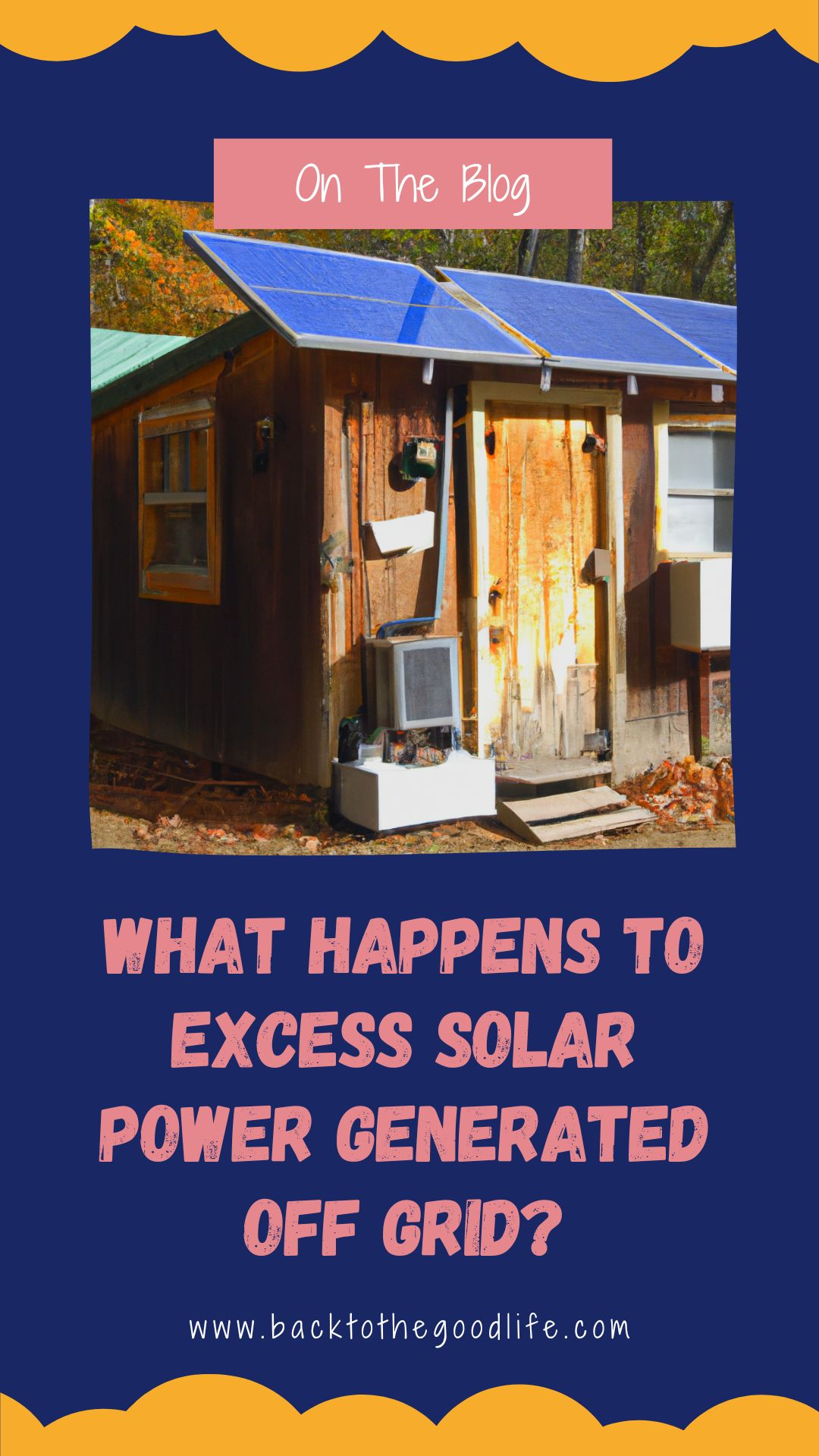Maximising Your Off Grid Solar: What to Do with Excess Energy
Just a heads up, this post contains some affiliate links. That means that we earn a small commission if you buy the product at no extra cost to you. That allows us to continue to research and share interesting articles with you. :)
If you want to go fully off grid in the UK, there are several things you will need to consider. One of the first things you need to assess is your energy needs and determine how much power you will need to generate to meet them. This will involve looking at how many appliances you use, how large your home is (or if you’re planning a self-build, how big your home will be), and what your typical energy consumption is or is estimated to be.

Once you understand your energy needs, you can start looking at the different renewable energy options available to you. This might include solar panels, wind turbines, or hydroelectric systems. You will need to choose the right system for your needs and budget, and consider factors such as the size of your property, the orientation of your roof, and the local climate.
In addition to a renewable energy system, you will also need to invest in batteries to store the power that you generate. This will allow you to use your renewable energy even when the sun isn’t shining or the wind isn’t blowing.
Finally, you will need to consider other aspects of going off grid, such as how you will heat your home and dispose of wastewater. For example, installing a wood-burning stove like this one or a septic tank may be necessary.
Living off grid can be a complex process, so it’s important to research and seek expert advice before you take the plunge.
Dealing With Excess Solar Power
When a solar power system is not connected to the grid, it is known as an off grid system. This means that the solar panels in the system will generate electricity that can be used to power your home or business, but any excess power that is generated will not be sent to the electric utility for others to use. Instead, it will be stored in a battery bank for later use.
If you have a solar power system that is not connected to the grid through systems like the Tesla Powerwall, any excess solar power that is generated by the system will be stored in a battery bank for later use. Suppose the battery bank is full, and you are still producing excess solar power.
In that case, it will be sent through an inverter, which will convert the direct current (DC) power generated by the solar panels into alternating current (AC) power that your household appliances can use. Any excess AC power that is not used by your appliances will be lost.
How To Use Your Excess Power

You can use the excess solar power generated by your off grid living system in several ways. One option is to use a surplus power meter to measure the amount of excess power produced and then use that power to run appliances or devices that are not critical to your daily operation. For example, you could use the excess power to charge your electric vehicle or run a pool pump.
Another option for using excess solar power is to invest in a backup generator like the AllPowers solar generator, which is incredible value for money when purchased with solar panels, or the more popular Ecoflow Delta Series that can be used in case of a power outage. This way, if your solar panels are not generating enough power to meet your needs, the generator can provide power to keep your appliances and devices running.
You could also consider installing a grid-tie inverter like the Growatt 3kW Hybrid Solar Inverter, which will allow you to sell excess solar power back to the electric utility. This can help offset the cost of your solar power system and potentially provide a financial return on your investment.
Off Grid Systems: Benefits & Disadvantages
There are several advantages to having an off grid solar power system, including the following:
- Independence: An off grid solar power system allows you to generate your own electricity, which means you are not reliant on the electric utility for your power needs. This can be especially useful in remote locations where grid access is limited or where natural disasters or other events can disrupt power service. Generating your own electrical power can also be a big step in any self sufficiency plans you have too!
- Cost savings: An off grid solar power system can help you save money on your electricity bills, especially if you are able to generate all of the power you need from your solar panels. This can be particularly attractive for people living in areas with high electricity rates.
- Environmental benefits: Solar power is a clean, renewable energy source that does not produce any greenhouse gases or other pollutants. By reducing your reliance on the electrical grid generating your own power with solar panels, you can help reduce your carbon footprint and contribute to a cleaner environment.
- Reliability: An off grid living solar power system is a reliable source of electricity, as long as you have a good solar resource and a properly maintained system. This can be especially important in areas where power outages are common.
There are also some disadvantages to having an off grid solar power system, including the following:

- Initial cost: The initial cost of an off grid solar power system can be relatively high, especially if you need to purchase batteries and other equipment to store the power that is generated by the system.
- Maintenance: Off grid solar power systems require regular maintenance to ensure that they operate efficiently and reliably. This can add to the overall cost of the system.
- Limited power: The amount of power that an off grid solar power system can generate is limited by the system’s size and the sunlight availability. This means that you may need to carefully manage your power use to ensure that you have enough electricity to meet your needs. You can mitigate this limitation by installing a hybrid system with alternative sources (such as hydroelectric or a home wind turbine like the Eco-Worthy 400W 12V Wind Turbine) or connecting to the grid when needed.
- Inability to sell excess power: If you generate excess solar power with an off grid system, you will not be able to sell it back to the electric utility. This means that you will not be able to offset the cost of your solar power system as you can with a grid-connected system.
What Happens If Solar Panels Produce Too Much Power?
If a solar power system produces more power than is needed, the excess power will be sent to a battery bank for storage. If the battery bank is full and the solar panels still produce excess power, the excess power will be lost unless it is used by appliances or other devices in the home.
In some cases, a grid-tie inverter can be installed to convert the excess power into alternating current (AC) power that can be used by household appliances. Any excess AC power that is not used by the appliances will be lost.
Battery Storage for Excess Solar Power
In an off grid solar power system, excess power is typically stored in a battery bank for later use. The battery bank is typically made up of one or more deep-cycle batteries that are specifically designed for use in renewable energy systems.

When the solar panels in the system generate excess power, it is sent to the battery bank, where it is stored until it is needed. When the battery bank is full and the solar panels are still generating excess power, the excess power will be lost unless it is used by appliances or other devices in the home.
There is no set limit to the number of batteries you can have in an off grid solar power system, but the size and capacity of your battery bank will be determined by your power needs and the amount of excess power that your solar panels generate.
As a general rule, if you’re serious about living off the grid, it is best to have a larger battery bank with more capacity if you have a high power demand or if you live in an area with limited sunlight. This will ensure that you have enough stored power to meet your needs during periods of low solar production.
Selling Excess Solar Power to the Grid
If you have an off grid solar power system, you will not be able to sell excess solar power back to the grid. This is because off grid systems are not connected to the electric utility, so there is no way to transfer the excess power to the grid.
If you want to be able to sell excess solar power, you will need to have a grid-connected solar power system, which is connected to the electric utility and can transfer excess power to the grid.
Net Metering & Feed-in Tariffs

Net metering is a system that allows people who generate their own electricity with renewable energy sources, such as solar panels, to sell excess power back to the electric utility. This is done by installing a bi-directional meter, which measures the flow of electricity in both directions.
When the renewable energy system is generating more power than the homeowner is using, the excess power is sent to the grid, and the meter spins backwards to give the homeowner a credit on their electricity bill. When the homeowner is using more power than their renewable energy system is generating, the meter spins forwards, and the homeowner is charged for the additional electricity they are using. Net metering allows homeowners with renewable energy systems to offset their electricity costs and potentially earn a financial return on their investment.
Feed-in tariffs (FITs) and net metering are similar but different. FITs and net metering allow people who generate their own electricity with renewable energy sources to sell excess power back to the electric utility. However, there are some key differences between the two.
One of the main differences between FITs and net metering is the way that the excess power is valued. With FITs, the electric utility must pay a fixed rate for the excess power generated by the renewable energy system. This rate is typically higher than the rate that the utility charges for electricity, so the homeowner can earn a profit by selling excess power to the grid. With net metering, the excess power is valued at the same rate as the electricity that the homeowner is charged for, so the homeowner will not earn a profit by selling excess power to the grid.
Another difference between FITs and net metering is the way that the excess power is credited to the homeowner’s account. With FITs, the excess power is typically credited to the homeowner’s account on a monthly basis, and the homeowner can use the credits to offset their electricity costs. With net metering, the excess power is credited to the homeowner’s account in real-time, so they will see the credit on their electricity bill as soon as the excess power is generated.
In summary, FITs and net metering are similar in that they allow homeowners with renewable energy systems to sell excess power back to the grid. However, there are some key differences between the two, including the way that the excess power is valued and credited to the homeowner’s account.
Can You Have Too Many Solar Panels When Living Off The Grid?
It is possible to have too many solar panels in an off grid solar power system, but this will depend on your power needs and your battery bank’s capacity. If you have more solar panels than you need to meet your power demand, the excess power will be sent to your battery bank.
If the battery bank is full and the solar panels are still generating excess power, the excess power will be lost unless you are using appliances or other devices that can use the power.
To avoid this situation, it is important to carefully calculate your power needs and ensure that your solar panel array is sized appropriately. You should also consider your battery bank’s capacity and how much excess power it can store.
If you are unsure about how many solar panels you need, it is best to consult a solar power professional who can help you determine the right size for your system.
Conclusion: Optimizing the Use of Solar Energy

To optimize your solar energy usage, there are several steps you can take, including the following:
- Conduct a thorough assessment of your power needs to determine the size and capacity of the solar panel array and battery bank that you will need. This will help ensure that your system is able to meet your power demand without generating excess power.
- Install a surplus power meter to track the amount of excess power your solar panels generate. This will help you identify times when you are producing more power than you need and adjust your energy usage accordingly.
- Invest in a backup generator that can provide power during periods of low solar production or in case of a power outage. This will help ensure that you have a reliable source of electricity even when your solar panels are not generating enough power.
- Consider installing a grid-tie inverter, which will allow you to sell excess solar power back to the electric utility. This can help offset the cost of your solar power system and potentially provide a financial return on your investment.
Overall, the key to optimizing your solar energy usage is to plan and design your solar power system carefully, and to monitor and adjust your energy usage as needed to ensure that you are using your solar panels efficiently.
Back To The Good Life is a participant in the Amazon Services LLC Associates Program, an affiliate advertising program designed to provide a means for sites to earn advertising fees by advertising and linking to Amazon.com. We also participate in other affiliate programs which compensate us for referring traffic.







